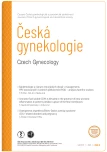Pánevní tamponáda při léčbě závažného poporodního krvácení po hysterektomii
Authors:
D. Habek 1; G. Pavlović 2; A. Cerovac 3
Authors‘ workplace:
University Department of Gynecology and Obstetrics, Clinical Hospital “Sveti Duh” Zagreb, Catholic University of Croatia Zagreb, Croatia
1; Department of Gynecology and Obstetrics, General Hospital Bjelovar, Croatia
2; Department of Gynaecology and Obstetrics, General Hospital Tešanj, Department of Anatomy, School of Medicine, University of Tuzla, Bosnia and Herzegovina
3
Published in:
Ceska Gynekol 2022; 87(6): 412-415
Category:
Case Report
doi:
https://doi.org/10.48095/cccg2022412
Overview
Úvod: Pánevní tamponáda (PP) jako jednoduchá metoda „chirurgický zákrok na odstranění škod” při těžkém abdominopelvickém krvácení v gynekologické a porodnické chirurgii po urgentním porodu nebo gynekologické hysterektomii. Cíl: Prezentovat případ úspěšné PP jako jednoduchá a účinná metoda u refrakterního pánevního krvácení po emergentní peripartální hysterektomii a těžkém porodnickém šoku s konsumpční koagulopatií. Kazuistika: Podle laboratorních nálezů a klinického stavu u 30leté rodičky (G2 P2) se v popisovaném případě jednalo s největší pravděpodobností o porodnickou embolii s rupturou dělohy jako příčinu těžkého poporodního krvácení s diseminovanou intravaskulární koagulopatií a rozvojem porodnického hemoragického šoku. Definitivním minimálně invazivním a jednoduchým hemostatickým postupem byla pánevní tamponáda po poporodní hysterektomii. Závěr: Použití PP a porodnických dovedností by mělo být zařazeno do protokolu jako nezbytný, život zachraňující a nekomplikovaný postup z vitální indikace.
Klíčová slova:
poporodní krvácení – porodnický šok – urgentní poporodní hysterektomie – pánevní tamponáda
Sources
1. Say L, Chou D, Gemmill A et al. Global causes of maternal death: a WHO systematic analysis. Lancet Glob Health 2014; 2 (6): e323–e333. doi: 10.1016/S2214-109X (14) 70227-X.
2. Habek D, Bečarević R. Emergency peripartal hysterectomy in a tertiary obstetric center: 8-year evaluation. Fetal Diagn Ther 2007; 22 (2): 139–142. doi: 10.1159/000097114.
3. Dildy GA 3rd. Postpartum hemorrhage: new management options. Clin Obstet Gynecol 2002; 45 (2): 330–344. doi: 10.1097/000 03081-200206000-00005.
4. Li B, Miners A, Shakur H et al. Tranexamic acid for treatment of women with post-partum haemorrhage in Nigeria and Pakistan: a cost-effectiveness analysis of data from the WOMAN trial. Lancet Glob Health 2018; 6 (2): e222–e228. doi: 10.1016/S2214-109X (17) 30467-9.
5. Guasch E, Gilsanz F. Massive obstetric hemorrhage: current approach to management. Med Intensiva 2016; 40 (5): 298–310. doi: 10.1016/j.medin.2016.02.010.
6. Logothetopulos K. Absolute succesfull antihemorrhagic methods in a vaginal and abdominal gynecological operations (in german). Zentralbl Gynakol 1926; 50: 3202–3204.
7. Howard RJ, Straughn JM Jr, Huh WK et al. Pelvic umbrella pack for refractory obstetric hemorrhage secondary to posterior uterine rupture. Obstet Gynecol 2002; 100 (5 Pt 2): 1061–1063. doi: 10.1016/s0029-7844 (02) 02 016-1.
8. Touhami O, Marzouk SB, Kehila M et al. Efficacy and safety of pelvic packing after emergency peripartum hysterectomy (EPH) in postpartum hemorrhage (PPH) setting. Eur J Obstet Gynecol Reprod Biol 2016; 202: 32–35. doi: 10.1016/j.ejogrb.2016.04.013.
9. Deffieux X, Vinchant M, Wigniolle I et al. Maternal outcome after abdominal packing for uncontrolled postpartum hemorrhage despite peripartum hysterectomy. PLoS One 2017; 12 (6): e0177092. doi: 10.1371/journal.pone.0177 092.
10. Mentula P, Leppäniemi A. Prophylactic open abdomen in patients with postoperative intra--abdominal hypertension. Crit Care 2010; 14 (1): 467–474. doi: 10.1186/cc8207.
11. Burchell RC. The umbrella pack to control pelvic hemorrhage. Conn Med 1968; 32 (10): 734–736.
12. Robie GF, Morgan MA, Payne GG Jr et al. Logothetopulos pack for the management of uncontrollable postpartum hemorrhage. Am J Perinatol 1990; 7 (4): 327–328. doi: 10.1055/ s-2007-999514.
13. Habek D, Živković K, Sović Lj et al. Postpartal pelvic hemorrhage in a patient with HELLP syndrome treated with hemostatic sponge. Z Geburtshilfe Neonatol 2018; 222 (5): 217–218. doi: 10.1055/a-0645-1598.
14. Carles G, Dabiri C, Mchirgui A et al. Uses of chitosan for treating different forms of serious obstetrics hemorrhages. J Gynecol Obstet Hum Reprod 2017; 46 (9): 693–695. doi: 10.1016/j.jogoh.2017.08.003.
15. Ghourab S, Al-Nuaim L, Al-Jabari A et al. Abdomino-pelvic packing to control severe haemorrhage following caesarean hysterectomy. J Obstet Gynaecol 1999; 19 (2): 155–158. doi: 10.1080/01443619965480.
16. Kim M, Cho H. Damage control strategy in bleeding trauma patients. Acute Crit Care 2020; 35 (4): 237–241. doi: 10.4266/acc.2020.00941.
Labels
Paediatric gynaecology Gynaecology and obstetrics Reproduction medicineArticle was published in
Czech Gynaecology

2022 Issue 6
Most read in this issue
- Nová kombinovaná perorální antikoncepce obsahující estetrol: přehledový článek evropského panelu odborníků
- Endometrióza v postmenopauze
- Vybrané patologické stavy ovlivňující receptivitu endometria
- Karcinom vulvy a jeho recidivy – zásady operační léčby
